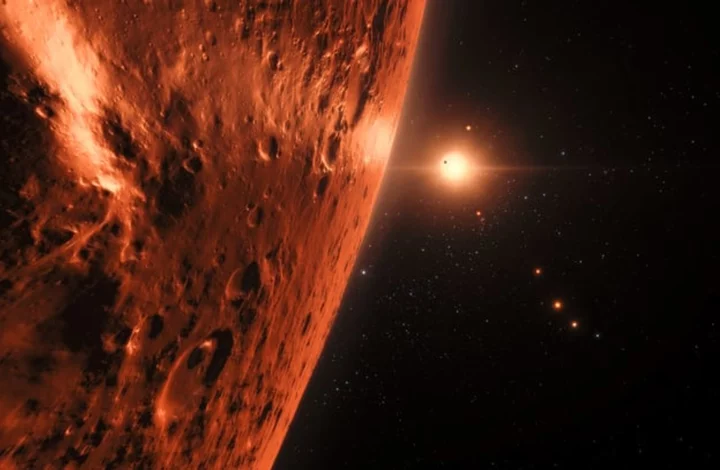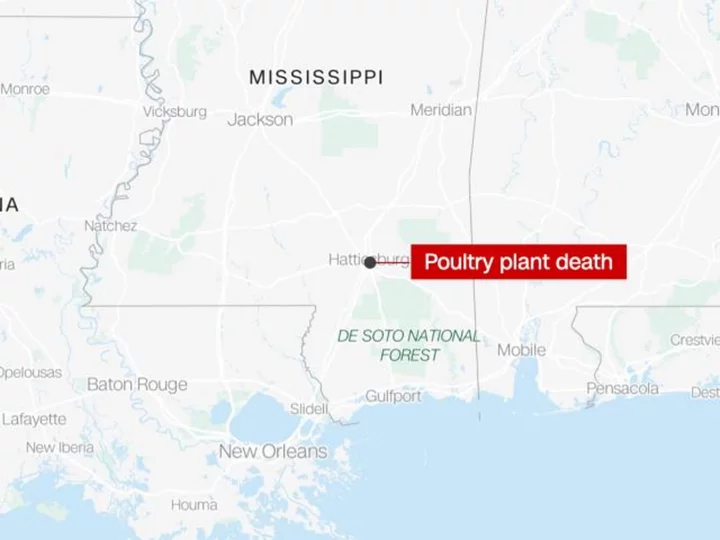The rocky worlds of the TRAPPIST solar system have captivated scientists.
Until recently, these Earth-sized planets beyond our solar system, called exoplanets, have remained largely mysterious. But researchers suspect some could host water, and maybe even conditions suitable for extraterrestrial life. With the power of the James Webb Space Telescope — the most advanced space observatory ever built — astronomers can analyze these worlds in unprecedented detail. So far, Webb has viewed the two closest planets to their star, TRAPPIST-1.
Scientists recently trained the Webb telescope on TRAPPIST-1 c, the second of the seven-known TRAPPIST planets, and one that orbits just some 1.5 million miles from its small "red dwarf" (also called an "M dwarf") star. They published the research in the science journal Nature. Astronomers found this hot planet likely doesn't harbor a thick atmosphere (perhaps similar to Venus), as astronomers once speculated, and instead has little to no water and isn't a great candidate for habitability. There are more TRAPPIST planets, however, for Webb to deeply observe.
"TRAPPIST-1 c is interesting because it’s basically a Venus twin: It’s about the same size as Venus and receives a similar amount of radiation from its host star as Venus gets from the sun," Laura Kreidberg, an exoplanet researcher at the Max Planck Institute for Astronomy and a study coauthor, said in a statement. "We thought it could have a thick carbon dioxide atmosphere like Venus."
(The planet is hot, at some 225 degrees Fahrenheit on its dayside, but not nearly as warm as scorching Venus, which is as hot as a pizza oven.)
SEE ALSO: Stunning Webb telescope photo shows actual bending of spacetimeThe Webb telescope is well-equipped to peer into distant solar systems. Its mirror is over 21 feet across, over two and a half times larger than the Hubble Space Telescope's, allowing it to capture extremely faint light from exoplanets in our Milky Way galaxy.
In the case of TRAPPIST-1 c, located some 40 light-years away from Earth, astronomers used a clever strategy to sleuth what is, or isn't, in the atmosphere. They watched the world pass behind its star four times, allowing researchers to compare the total brightness when the planet was beside the star (TRAPPIST-1 c plus light from its star) versus just starlight. This let astronomers determine how much of a certain type of light, which is absorbed by CO2, was present on this extraterrestrial world. Ultimately, they found little evidence of CO2.
An artist's conception of the exoplanet TRAPPIST-1 c. Credit: NASA / ESA / CSA / Joseph Olmsted (STScI) The light the Webb telescope captured from TRAPPIST-1 c, showing a thin atmosphere. Credit: NASA / ESA / CSA / Joseph Olmsted (STScI)"Our results are consistent with the planet being a bare rock with no atmosphere, or the planet having a really thin CO2 atmosphere (thinner than on Earth or even Mars) with no clouds," Sebastian Zieba, a graduate student at the Max Planck Institute who led the research, said in a statement.
Finding the likely nature of TRAPPIST-1 c, and the forthcoming TRAPPIST planets Webb will investigate, requires extreme telescope sensitivity.
"The sensitivity required to distinguish between various atmospheric scenarios on such a small planet so far away is truly remarkable," NASA explained. "The decrease in brightness that Webb detected during the secondary eclipse was just 0.04 percent: equivalent to looking at a display of 10,000 tiny light bulbs and noticing that just four have gone out."
The reality that so far two TRAPPIST planets have profoundly thin atmospheres and no signs of water could mean the other sibling TRAPPIST planets — though farther away from their star and existing in more temperate environments — still might have little water or ingredients for a habitable world.
Or not. Webb will help us find out.
"Webb is so sensitive that it can search for elements and molecules like oxygen, nitrogen, and carbon dioxide in exoplanet atmospheres," NASA tweeted. "The mystery remains — can planets orbiting small M dwarfs sustain the atmospheres needed to support life as we know it?"
The Webb telescope's powerful abilities
The Webb telescope — a scientific collaboration between NASA, the ESA, and the Canadian Space Agency — is designed to peer into the deepest cosmos and reveal unprecedented insights about the early universe. But it's also peering at intriguing planets in our galaxy (like the TRAPPIST worlds), and even the planets in our solar system.
Want more science and tech news delivered straight to your inbox? Sign up for Mashable's Light Speed newsletter today.
Here's how Webb is achieving unparalleled things, and likely will for decades:
Giant mirror: Webb's mirror, which captures light, is over 21 feet across. Capturing more light allows Webb to see more distant, ancient objects. As described above, the telescope is peering at stars and galaxies that formed over 13 billion years ago, just a few hundred million years after the Big Bang.
"We're going to see the very first stars and galaxies that ever formed," Jean Creighton, an astronomer and the director of the Manfred Olson Planetarium at the University of Wisconsin–Milwaukee, told Mashable in 2021.
Infrared view: Unlike Hubble, which largely views light that's visible to us, Webb is primarily an infrared telescope, meaning it views light in the infrared spectrum. This allows us to see far more of the universe. Infrared has longer wavelengths than visible light, so the light waves more efficiently slip through cosmic clouds; the light doesn't as often collide with and get scattered by these densely packed particles. Ultimately, Webb's infrared eyesight can penetrate places Hubble can't.
"It lifts the veil," said Creighton.
Peering into distant exoplanets: The Webb telescope carries specialized equipment called spectrometers that will revolutionize our understanding of these far-off worlds. The instruments can decipher what molecules (such as water, carbon dioxide, and methane) exist in the atmospheres of distant exoplanets — be it gas giants or smaller rocky worlds. Webb will look at exoplanets in the Milky Way galaxy. Who knows what we'll find.
"We might learn things we never thought about," Mercedes López-Morales, an exoplanet researcher and astrophysicist at the Center for Astrophysics-Harvard & Smithsonian, told Mashable in 2021.









